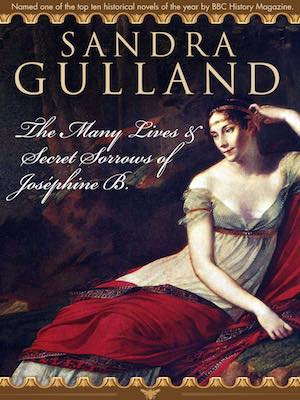by Sandra Gulland | Mar 30, 2012 | Adventures of a Writing Life |

Since sending off the sixth draft of The Next Novel to my publisher, I’ve been tackling what needs to be done to get my e-books launched.
Expanding the website
Yesterday was a big day, setting up website pages for each book. (Here’s the “catalogue page” so far. I have one page yet to set up, the link for the Trilogy omnibus edition.)
Moving this website to WordPress.org has been a good move: I can expand this site however I need, whenever I need. I sort of have a handle on it. I like learning how to do this type of thing, but setting up six new pages yesterday was intense.
Setting up an iTunes Connect account
At the end of the day, I needed to fill out the forms for setting up an iTunes Connect account. As a publisher now — and a Canadian publisher at that (which adds another level of complexity, I’ve discovered) — setting up accounts with all the “vendors” is a first step. With the help of Kris Waldherr, I’ve already set up accounts with Kindle, Nook and Kobo. The Apple account is the last. I thought it would be a snap. (Not!)
Help!
First: providing my bank information required a call to my TD bank in Ottawa and a “help!” email exchange to Apple to figure out the rather special bank transit number required. Another call to TD was needed to determine what the heck the bank’s “local identification number” was. (The bank didn’t know; we made a guess.)
Oh no! Tax forms?
Second: filling out U.S. and Canadian tax forms. The Canadian form is titled “Election and Revocation of an Election between Agent and Principal.” That gives you an idea. Basically, I think it means that I (the principal) and Apple (the agent) have agreed (elected) to have a relationship for the purpose of selling e-books. Fair enough: but why can’t legal forms be in simple English?
The U.S. form continues to baffle me.
If you are a disregarded entity with a single owner who is a foreign person and you are not claiming treaty benefits as a hybrid entity, this form should be completed and signed by your foreign single owner.
I don’t know about you, but this type of language turns my brain into a pretzel.
The good news is that once all the accounts are set up, it’s done. The bad news is that it is a bit of work of the harassing kind. I can see the advantage of e-book publishing through an agency or established e-book publisher, except for one thing: Sandra Gulland Ink is mine, forever and ever.

by Sandra Gulland | Mar 27, 2012 | Adventures of a Writing Life |

{Above: engraving by Georg Andreas Böckler, from the wonderful blog BibliOdyssey.}
I’m preparing to launch my e-books soon, and learning a lot in the process. Today’s lesson: the importance of what categories you assign to your book when you launch it.
You can read about this and other things (like key words) in detail on M. Louisa Locke’s excellent blog post, “Categories, Key Words, and Tags, Oh My: Why should an Author Care?“
The long and (mostly) short of it is that how you categorize your book will have a lot to do with how easily readers can find it, and, in turn, how many you will sell.
When I upload a book to Amazon Kindle, I will be given the opportunity to assign two categories to it. (Note to self: be prepared for the possibility that it will be different for Amazon.uk.) Formerly, it was five, but that has changed.
If I select “Fiction —> Historical Fiction” (and how can I not?), my book will be competing against almost 20,000 other titles for the top-100 spot. In other words: impossible!
On the other hand, if I chose History —> Europe —> France, my book will only be competing against a little over 1000 titles. I might have a chance to be seen.
A number of young adults read the Trilogy — in fact, it is sometimes used as a teaching tool in high schools — so should I consider a YA category? It’s tempting, because by putting it in Fiction —> Children’s Fiction —> Historical Fiction —> Europe, it would only compete against 280 titles.
Yet would I? I doubt it. (Only getting to chose two makes it tough!)
Clearly, there is a problem with the categories offered. How can Historical Fiction for children be divided into many sub-categories, yet all Historical Fiction for adults is lumped together in one big stew pot. Genres like Mystery have numerous sub-categories, so why not Historical Fiction? There could be categories for country and era, as well as for literary, commercial, romance or time-travel, for example. Then readers would be able to find exactly what they are looking for.

Afternote: there is a difference between Kindle e-book categories in the U.S. and U.K. In the categories I checked, there are more sub-categories offered in the U.S. Curiously, the categories for books and e-books are different throughout. Why? It’s a maze.

by Sandra Gulland | Mar 17, 2012 | Adventures of a Writing Life, Publication, Sandra Gulland INK, The Many Lives & Secret Sorrows of Josephine B. |
I mentioned in an earlier post that I’ll soon have my Sandra Gulland Ink e-books up. In the words of a youngster I know, “Soon is a very long time.” We are close — very close! — but for the concern that a few typos remain.
I proofed the files in France last summer, in the backseat of a car full of film crew, radio blaring. Not ideal!
Since then, Kris Waldherr, designer and tech wizz, read about half the chapters, and found typos. There are others, no doubt, and I’m on deadline revising This Bright Darkness: so no time to spare!
Here is the request. Are there any of you who 1) have an iPad, and 2) would be willing to read the new digital edition of The Many Lives & Secret Sorrows of Joséphine B.?
If so, I’d email you the file with instructions on how to get it into iBook. Then all you would have to do is read it, highlight whatever errors you find, and email them to me. (iBook makes this very easy.)
If you are interested, let me know! sgulland AT sandragulland DOT com.





